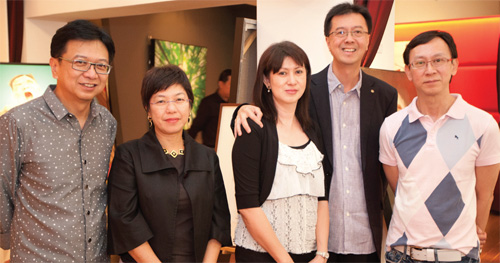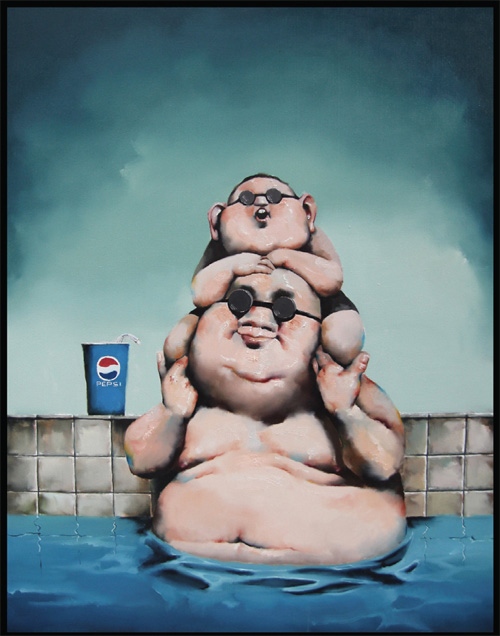Xi Yan’s first ever contemporary Chinese art exhibition turns up a treasure trove of fine craftsmanship and promising talents.
Contributed By Yong Yung Shin
Before contemporary Chinese art took international auction houses by storm with their multi-million-dollar price tags, brothers Thomas Choong and his brother Yin Lee were already ardent collectors.
Over the weekend of May 20 to 22, they held their first ever art exhibition at their restaurant, Xi Yan, situated along Craig Road, which featured 56 paintings from their private collection which started in 1983. The paintings are priced from S$1,800 to S$16,000.
The inspiration for the exhibition came because over the years, Thomas kept getting queries from patrons about the artwork adorning the walls of Xi Yan, and many requested to purchase the paintings for their home or offices.
So, marrying their love for both fine Chinese food and art, the brothers decided to hold an exhibition, titling it “Banquet of Joy, Joy of Art.” It was curated by art writer Joan Yap. While the launch on the evening of May 20 was an invitation-only cocktail event attended by ministers and dignitaries, the weekend sessions were open to the public for free.
On site to walk visitors through the collection, Yin Lee gave his take on the surge of interest in Chinese art. “When the Cultural Revolution ended, there was all this pent-up emotion just looking for outlets of expression; the resulting renaissance of ideas is thus incredibly exciting.”
Artists featured included Chen Xiao Cun, a 31-year-old Fujian native whose evocation of zebra in his paintings seems to allude to the displacement of non-indigenous “animals” such as migrant workers or global citizens. “His work may look whimsical or pretty, but there is also a lot of depth in each painting, characterized by a distinctive style,” said Yin Lee.
Some of the most eye-catching paintings in the collection are by Cai Jun, a graduate from the Sichuan Art Academy. The artist’s mischievous side speaks loud and clear in his paintings, which are able to elicit laughter at first glance, such as those in the PIG Series—one shows a “Cupig” (a Cupid pig) intoxicated with joy as he goes in search of his “victims”; another captures the irony of life as a weary-looking driver “chauffeurs” his passenger, an obliviously blissful pig, to the slaughterhouse.
TRAINING THE EYE
For anyone interested in jumping on the bandwagon, curator Yap’s advice is to “train the eye” by exposing oneself to as much art as possible—be it a sculpture, installation art or performing art. “It’s like eating spaghetti; once you have eaten many types, you will know what kind you like best. Then you start to have an idea of the kind of art that invokes a certain feeling in you. First the eye, then the heart.”
Asked about the criteria for a “quality” piece of art, Yap replied, “Firstly, it’s the technique; the artist’s mastery of painting. Then comes the artist’s portrayal of subjects—how well he communicates his message and his ideals. But in order to grasp this, you also need to research about the artist and his experiences in order to understand his point of view and what he’s trying to say.”
Yin Lee says, “A good piece of art has to stir up or instigate something in you, whether the subject is pleasant or unpleasant.”
In a way, as the collector expands his collection, he fosters a relationship with the artist. “A responsible collector is not one who buys a piece of art in the hope of selling it the next day to make money. It’s not a commodity but part of a personal journey. The artists go through a lot of internal struggles and ideology, so when you buy a piece of artwork, you are buying a piece of the artist himself,” says Yap.
For anyone who feels overwhelmed by art’s abstract nature, rest assured that most art connoisseurs started out this way. Yap herself began nurturing an interest in art through realistic paintings, by admiring the technique and craftsmanship of the artist for being able to depict real-life objects so vividly. She then started to explore ways of seeing life represented in a different, more conceptual way.
So how does a person know that he’s ready to buy his first piece of art? “Know that there’s no need to rush to appreciate art. The appreciation comes with time and effort,” advised Yap. “Once when you have seen enough to know what you want, that is when you don’t wait. At the end of the day, you have to be able to see a piece day in, day out and still attach feelings or memories to it that move you or trigger an emotion in you.”
Art Appreciation 101

(From left) Thomas Choong, Joan Yap and Choong Yin Lee (far right). PHOTO COURTESY OF XIYAN PRIVATE DINING
The classic four-step guideline for novices who want to hone their understanding and appreciation of art.
• Description: What do I see?
• Analysis: What are the subjects doing? How are they composed or positioned within the picture?
• Interpretation: What is the artist trying to communicate?
• Critique: Can you relate to it? Does it make you feel something? Do you like it?



